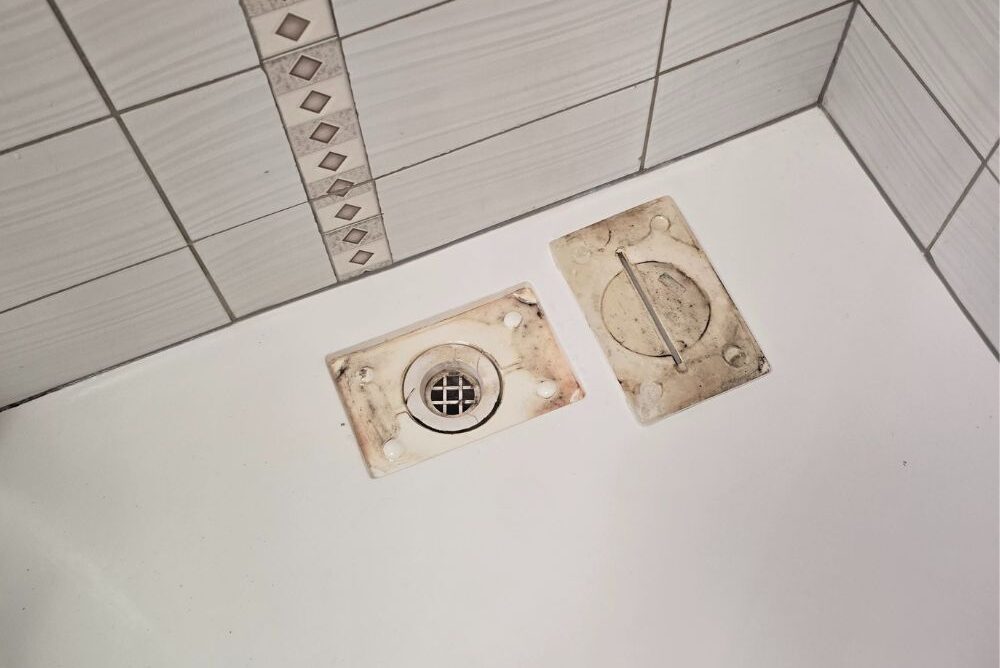Taking a shower is one of the most relaxing parts of the day — until you’re standing in a puddle because the drain is blocked.
It can be frustrating, but don’t stress!
You can usually solve minor issues with natural methods like white vinegar or hot water.
But if those don’t work, you might need to grab a plunger or a drain snake.
In this guide, we’ll explain how to clean a shower drain in detail — from routine maintenance to tackling a tough clog.
How Often to Clean | Before Cleaning | What You’ll Need | Routine Cleaning | Deep Cleaning | Cleaning a Smelly Shower Drain | Preventing Clogs
Why Clean Shower Drains
You might think shower drains don’t get dirty. After all, only water and soap suds pass through, right?
Well, not quite!
Hair, soap scum, body oils, and other debris can build up in the drain pipe and create a gooey mess.
That can slow down water flow and cause a stubborn blockage if ignored.
Clogged drains also encourage bacterial growth, mould, and mildew, which can give off a foul smell.
Regular cleaning helps prevent clogs and bad odours in your shower drain. It will also save you from costly plumbing repairs.
How Often to Clean Your Shower Drain
To keep your shower drain working well, pick up any hair and debris as soon as you see them.
Then, clean the drain weekly — it should be part of your regular shower maintenance.
Just make sure that water flows freely down the drain before working on the shower floor, tiles, or door.
If you’re short on time or find shower cleaning too exhausting, reach out to a professional cleaning service.
They’ll leave your entire bathroom fresh and sparkling from top to bottom!
Before Cleaning Your Shower Drain
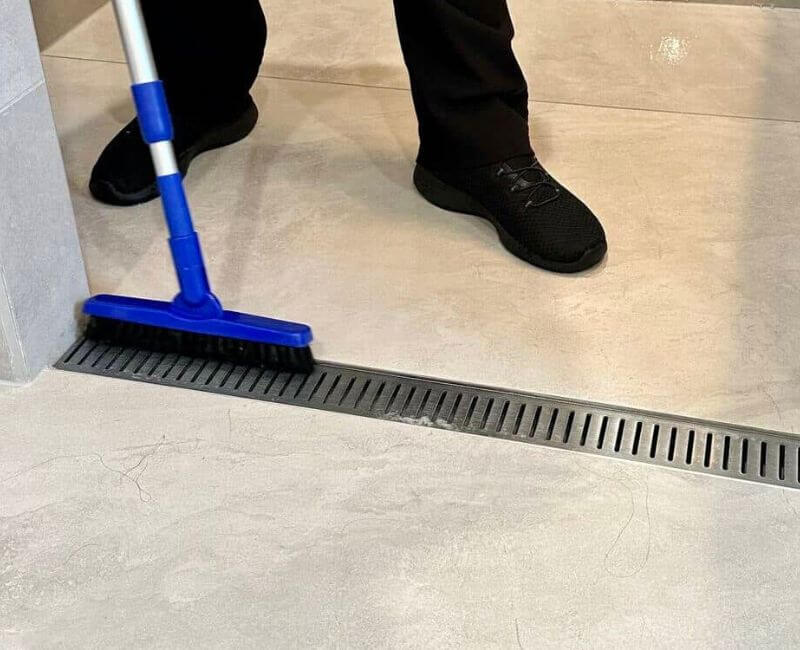
Some cleaning products release strong odours that might be harmful to breathe in.
Clogged shower drains may also contain bacteria or viruses that can cause illnesses, or create unpleasant smells.
To protect yourself, wear rubber gloves and a mask while cleaning. It also helps to switch on the exhaust fan or open a window for good airflow.
Then, clear the area so you have enough space to move. Take down the shower curtain if you have one, and remove any shampoo bottles, mats, and other items.
If you have PVC pipes, do not pour boiling water down, as excessive heat can warp the material.
Also, avoid using harsh chemicals like bleach and lye-based solutions too often, since these can corrode the pipes.
And never mix different cleaning products, as some combinations — like vinegar and bleach — can be toxic.
What You’ll Need to Clean Your Shower Drain
To clean your shower drain, prepare the following materials:
- Old bottle brush or toothbrush
- Cup plunger or drain snake
- White vinegar
- Hot water
- Dish soap
Routine Cleaning Steps for Shower Drains
Whether you have a point drain (has a round or square cover) or a linear drain (a long, narrow channel), the cleaning steps are mostly the same.
The difference is that linear types usually have extra parts that need attention, like the drain channel or tray.
Step 1. Remove the drain cover
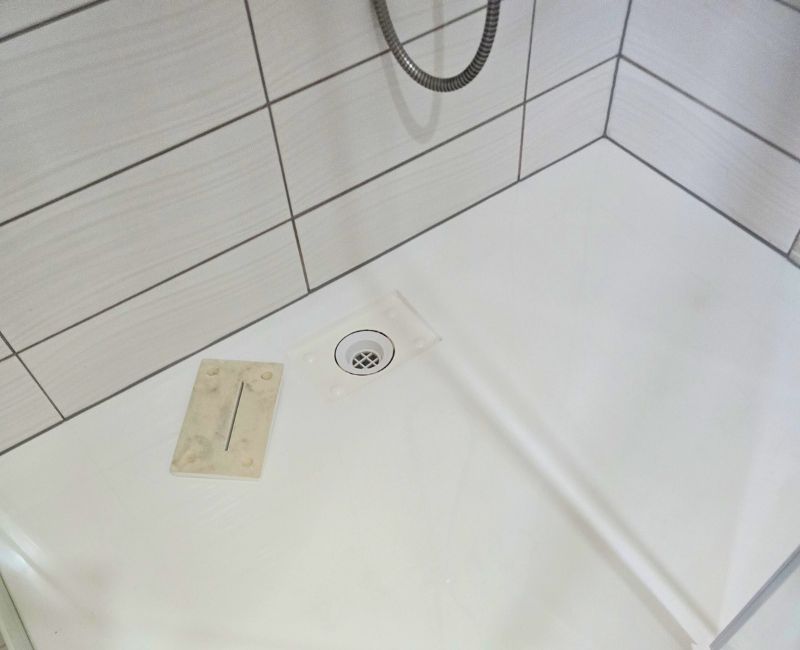
Remove the cover to access the shower drain.
For point shower drains, the cover may just be snapped in place, so it would easily lift out.
For linear shower drains (also called strip drains), you might need a thin hook, like one from a wire hanger. Slide it in, catch the edge of the cover, and pull it up.
If the cover is screwed in, use the right screwdriver to remove it. Handle with care to avoid any damage.
Once the cover is off, remove any detachable parts such as strainers or hair catchers. Set these aside for cleaning later.
Step 2. Pick up hair and debris
Peek into the shower drain opening, then pull out any clumps of hair and debris buildup.
If you’d rather not use your hands, you can pick it up with a pair of tweezers.
Throw away the gunk in the trash. Do not flush it down the drain or the toilet to avoid clogs.
Step 3. Clean all shower drain components
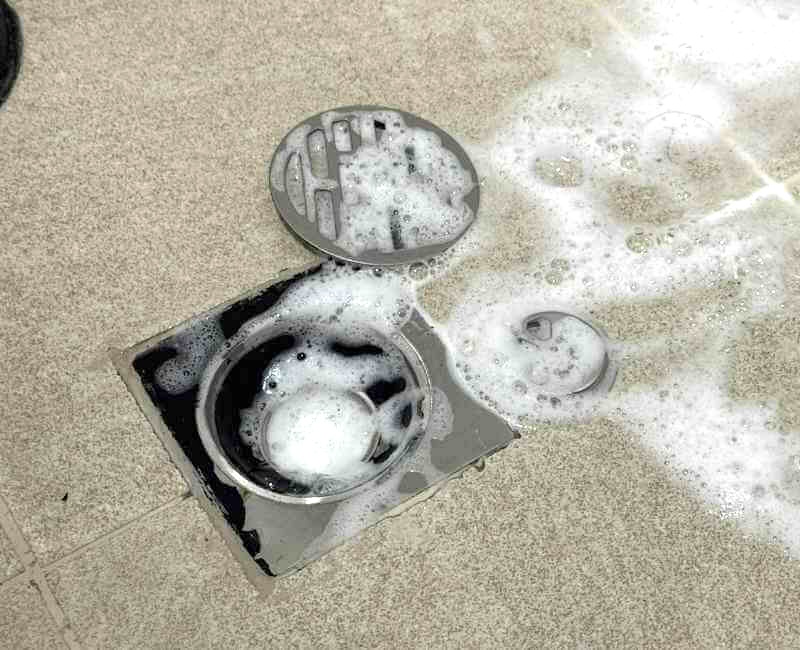
Make sure to clean all the parts of the drain that you removed earlier, including the cover or strainer.
For linear drains, you also need to tackle the water channel or tray. It’s typically fixed onto the shower floor, so you need to clean it in place.
Mix warm water and a little dish soap in a spray bottle, and mist the shower drain components.
Let it sit for 10–15 minutes, then scrub gently with an old toothbrush.
Afterwards, rinse each piece thoroughly and wipe dry with a soft cloth.
Step 4. Scrub the shower drain opening
Spray warm, soapy water onto the shower drain opening. Be sure to coat the rim and the sides of the pipe.
Then, grab an old bottle brush and gently scrub along the edge and the inside of the drain pipe. This helps loosen soap scum and other buildup.
You don’t need to go too far down into the pipe. Just be sure to remove as much debris as you can from the accessible parts.
Step 5. Flush the shower drain pipe
After removing all visible grime, it’s time to clean deeper inside the plumbing, including the P-trap (the curved section of the pipe).
To clean the shower drain naturally, just pour 2 cups of white vinegar down the opening.
Then, follow it up with hot (not boiling!) water. Around 50°C–60°C is enough, so you don’t end up damaging the pipe.
This helps wash away grime and break down minor clogs.
NOTE: Do not mix baking soda and vinegar. When combined, they’ll neutralise each other, which reduces their cleaning power.
Using too much baking soda can also clog the drain!
Step 6. Reassemble the shower drain
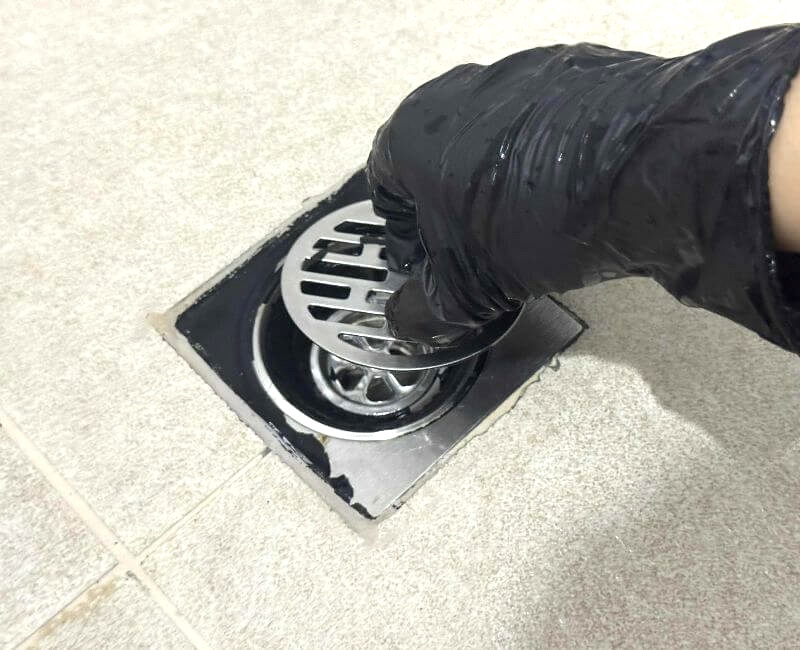
When you’re done, check the shower floor for any debris. Pick up any mess, and wipe the surface with a damp cloth.
Reinstall all components you removed earlier, including the cover. Make sure everything is secured properly and doesn’t shift out of place.
How to Deep Clean a Shower Drain
Sometimes, hair and other debris can get stuck deeper down the drain or in the P-trap.
When that happens, natural methods like vinegar or hot water might not be enough to clear the clog.
In this case, you’ll need to deep clean the shower drain and trap.
Before you start, remove the drain cover and all detachable parts. Also, wear a mask, gloves, and eye protection, since the process can get messy.
Option 1. Cup plunger
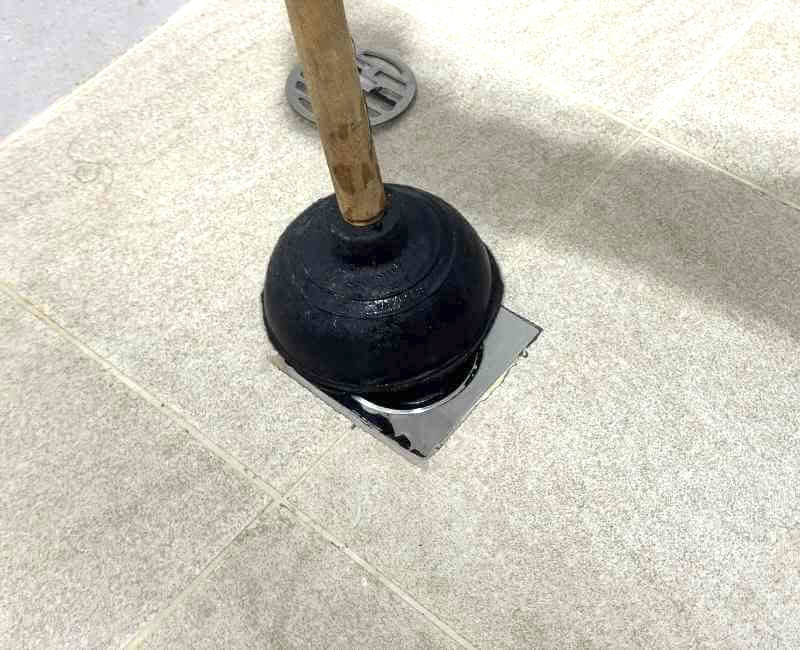
If there’s standing water in your shower, a plunger is an effective method to unclog the drain.
Use a cup plunger, which has a wide, flat base designed for level surfaces like shower floors, tubs, or sinks.
Note that a cup plunger is ideal for point drains. If you have a linear drain, it may not fit into the narrow water channel.
For the plunger to work, the shower floor must be filled with enough water, at least 5cm high. This helps maintain a seal around the plunger cup.
Next, place the plunger directly over the drain’s opening. The cup should cover the hole completely.
Push down the plunger gently, then pump up and down vigorously 10–15 times. While doing this, keep the rim pressed firmly against the floor.
This creates pressure and suction, which can help dislodge the blockage.
When you’re done, remove the plunger and check the water flow. If it’s still slow, you might need to repeat the process.
Option 2. Drain snake
Another tool that can remove stubborn clogs is a drain snake (also called a plumber’s snake or auger).
It’s a long, flexible cable with a coiled tip that’s designed to pull out debris from drains.
Insert the end of the drain snake into the pipe’s opening. Push it into the pipe, turning the crank as you go so it can navigate any curves.
You’ll know you’ve reached the clog when you feel resistance and can’t push any further.
Keep turning the snake to snag the hair and debris, then slowly pull it back out.
Expect a gross wad of gunk to come out — dispose of it straight in the trash!
Run water to test the drain, and repeat the steps until the water flows freely.
Option 3. Chemical drain cleaners
For serious clogs, you can use a chemical shower drain cleaner — but only as a last resort!
Keep in mind that these products can damage the pipes when used too often, and they’re not advisable for older drainage systems.
They’re also not safe for septic tanks, as they can kill beneficial bacteria that help break down waste.
If you’re using a chemical drain cleaner, you have two options: caustic cleaners or acidic cleaners.
Caustic cleaners are highly alkaline and usually contain sodium hydroxide (also called lye or caustic soda).
On the other hand, acidic cleaners contain high concentrations of sulfuric acid or hydrochloric acid.
Both types can work on a heavy buildup of grease, hair, and soap scum. Just make sure to carefully read and follow the instructions on the label.
IMPORTANT: Always wear a mask, gloves, and safety goggles when using harsh chemicals, and never mix them with other cleaning solutions!
How to Clean a Stinky Shower Drain
If there’s a bad smell coming from your shower drain, there are a few possible causes.
One culprit is a dry P-trap. The P-trap is designed to hold a small amount of water to block sewer gases from entering the bathroom.
But if you haven’t used your shower in a while, the water in the drain trap can dry out.
If that’s the case, just run water for a couple of minutes to refill the trap and the smell should fade.
But if the odour is still there, it may be due to clogs or bacterial growth deep down the drain pipe.
Try to remove any blockage from your shower drain with a cup plunger or drain snake. Also, clean the pipe’s opening and the removable parts thoroughly.
When you’re done, pour vinegar then hot water down the pipe. This works well for removing funky smells.
How to Prevent Clogs in Your Shower Drain
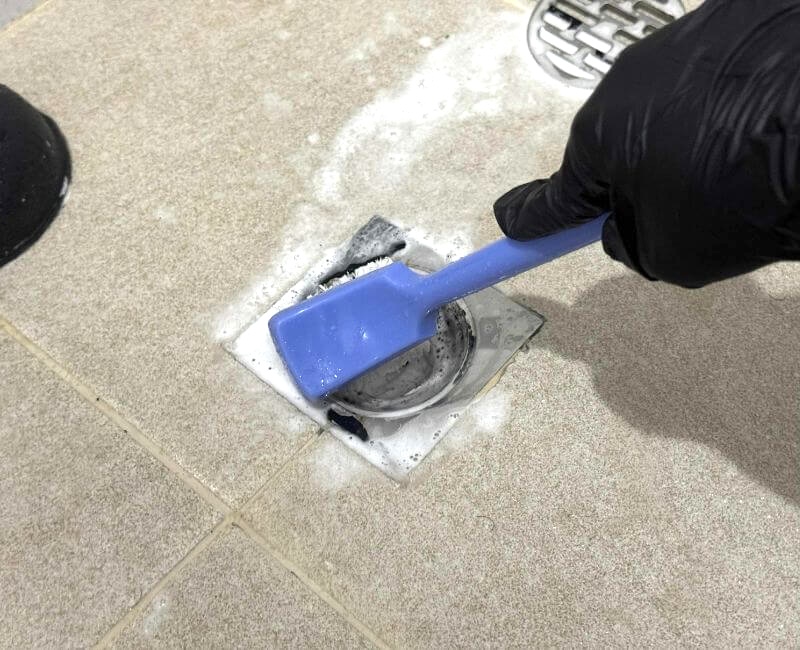
Preventing clogs in your shower drain is much easier than dealing with stubborn blockages deep inside the pipes.
Regular cleaning is key, so pick up any hair you see on the drain cover as soon as you notice it.
You can also use a hair catcher. Place it over the cover to keep hair and debris from going down.
If you notice the drainage slowing, address it right away. Don’t wait for a minor issue to turn into a major one.
You can also use commercial drain cleaners with bio-enzymes. They contain beneficial bacteria that gradually break down grime to prevent blockages.
That said, these products are designed for long-term maintenance, unlike chemical cleaners that work immediately on tough clogs.
Bio-enzyme solutions are also safer for plumbing and septic systems.
Finally, stick to your weekly bathroom cleaning routine to prevent buildup and keep the drain clear.
FAQs About Cleaning Shower Drains
Still have questions about your shower drain?
Here’s everything you need to know to make sure it stays clog-free!
What is the best way to clean a shower drain?
The best way to clean a shower drain is with natural methods like vinegar and hot water.
You can also use a shower drain cleaner with bioenzymes to help dissolve buildup and stop bacterial growth.
For stubborn clogs, a cup plunger or a drain snake works well.
Avoid using boiling water and strong chemical cleaners, as these can damage the pipes beneath.
How to clean a shower drain that can’t be removed
For minor clogs, pour 2 cups of white vinegar down the drain, followed by hot water.
Just note that cleaning a shower drain with a fixed cover can be tricky, so it’s more important to prevent clogs.
Place a hair catcher over the drain to trap hair, and pick up any debris on the cover as soon as you notice it.
Also, consider asking a professional about replacing your drain with a removable option.
How to clean a shower drain trap
You can clean the shower drain P-trap using these solutions:
- Vinegar
- Hot water
- A bioenzymatic cleaner
For stubborn clogs, use a cup plunger or a snake drain.
How do you minimise mess when unclogging a shower drain?
Start by clearing the area to avoid any splashes from landing on other objects like the shower curtain or toiletry bottles.
For minor clogs, try easy methods first, like vinegar or hot water.
If you’re using a drain snake, line the floor with old newspapers or cardboard to catch any debris.
On the other hand, using a cup plunger can be messier, since you need to fill the shower with some water.
Keep a bin nearby to dispose of any gunk right away, and always wear gloves to keep your hands clean.
Can you clean the shower drain with a toilet plunger?
A toilet plunger can sometimes work on a shower drain, but it’s not the best choice.
Toilet plungers have an extra rubber flap that’s designed to fit inside toilet openings.
They might not fully cover the drain’s opening and fail to create the seal needed for pressure and suction.
For shower drains, use a cup plunger instead.
How do you unblock a shower drain with standing water?
Start with a cup plunger. The water should be at least 5cm deep, so you may need to add more.
If plunging doesn’t work, try a drain snake. But first, remove as much water as possible for easier access.
What can dissolve hair in a shower drain?
Chemical drain cleaners can break down hair clogs, but they’re harsh on pipes and septic systems.
There are other effective methods to remove hair clumps from the drain, like a cup plunger or a drain snake.
Try those first, and reserve chemical cleaners as a last option.
When to seek professional help
If you tried everything to unclog the shower drain and nothing worked, it’s time to call a plumber.
Also, watch out for:
- Gurgling sounds from the pipes
- Persistent bad smell even after cleaning
- Clogs that affect multiple areas (e.g., toilet, sink)
These often point to a bigger issue that DIY methods might not solve.

